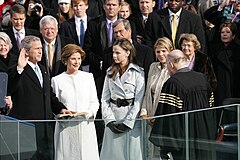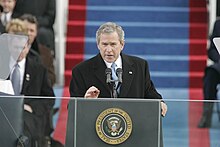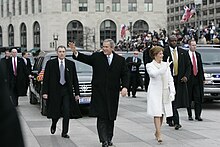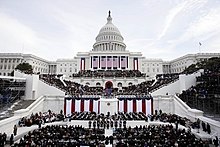
William Lewis Safire was an American author, columnist, journalist, and presidential speechwriter. He was a long-time syndicated political columnist for The New York Times and wrote the "On Language" column in The New York Times Magazine about popular etymology, new or unusual usages, and other language-related topics.

The 2004 Republican National Convention took place from August 30 to September 2, 2004, at Madison Square Garden in New York City, New York. The convention is one of a series of historic quadrennial meetings at which the Republican candidates for president and vice president, and party platform are formally adopted. Attendance included 2,509 delegates and 2,344 alternate delegates from the states, territories and the District of Columbia. The convention marked the formal end of the active primary election season. As of 2023, it is the most recent major-party nominating convention to be held in New York City.

On January 20, 2005, a number of counter-inaugural demonstrations were held in Washington, D.C., and other American cities to protest the second inauguration of President George W. Bush.

Between 73 and 79 days after the presidential election, the president-elect of the United States is inaugurated as president by taking the presidential oath of office. The inauguration takes place for each new presidential term, even if the president is continuing in office for a second term.
Turn Your Back on Bush was a form of protest in the United States to express dissatisfaction with former President George W. Bush. The first known protest took place on June 14, 2002, in Columbus, Ohio, where President Bush delivered a commencement address to the graduating class of Ohio State University and an audience of over 50,000 people.

The first inauguration of Barack Obama as the 44th president of the United States took place on Tuesday, January 20, 2009, at the West Front of the United States Capitol in Washington, D.C. The 56th inauguration, which set a record attendance for any event held in the city, marked the commencement of the first term of Barack Obama as president and Joe Biden as vice president. Based on combined attendance numbers, television viewership, and Internet traffic, it was one of the most-observed events ever by the global audience at the time.

The first inauguration of Bill Clinton as the 42nd president of the United States was held on Wednesday, January 20, 1993, at the West Front of the United States Capitol in Washington, D.C. This was the 52nd inauguration and marked the commencement of the first term of Bill Clinton as president and Al Gore as vice president. At 46 years, 154 days of age at the time of his first inauguration, Clinton was the third-youngest person to become president, and the first from the Baby Boomer generation.
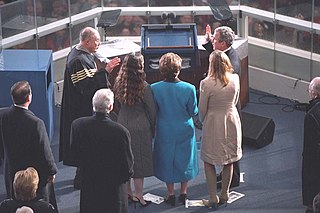
The first inauguration of George W. Bush as the 43rd president of the United States took place on Saturday, January 20, 2001, at the West Front of the United States Capitol in Washington, D.C. This was the 54th inauguration and marked the commencement of the first term of George W. Bush as president and Dick Cheney as vice president. Chief Justice William Rehnquist administered the presidential oath of office at 12:01 p.m., after he administered the vice presidential oath of office as well. An estimated 300,000 people attended the swearing-in ceremony. This was the first presidential inauguration to take place in the 21st century, and the first in the 3rd millennium.

The inauguration of George H. W. Bush as the 41st president of the United States was held on Friday, January 20, 1989, at the West Front of the United States Capitol in Washington, D.C. This was the 51st inauguration and marked the commencement of the only term of both George H. W. Bush as president and Dan Quayle as vice president. Chief Justice William Rehnquist administered the presidential oath of office to Bush and Justice Sandra Day O'Connor administered the vice presidential oath of office to Quayle. Bush was the first sitting vice president to be inaugurated as president since Martin Van Buren in 1837 and the last World War II combat veteran. Bush composed his own prayer for the ceremony which he recited at the start of his inaugural address; the last president to do so was Dwight D. Eisenhower at his first inauguration in 1953.

The second inauguration of Ronald Reagan as president of the United States was held in a televised ceremony on January 20, 1985, at the White House, and was repeated the following day, January 21, 1985, at the Capitol's rotunda. This was the 50th presidential inauguration and marked the commencement of the second and final four-year term of both Ronald Reagan as president and of George H. W. Bush as vice president. At 73 years, 349 days of age on Inauguration Day, Reagan was the oldest U.S. president to be inaugurated, until Joe Biden's inauguration as president on January 20, 2021, at the age of 78 years, 61 days.
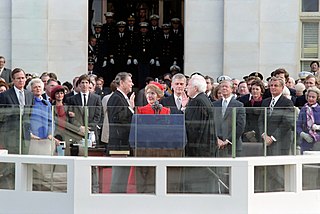
The first inauguration of Ronald Reagan as the 40th president of the United States was held on Tuesday, January 20, 1981, at the West Front of the United States Capitol in Washington, D.C. This was the first inauguration to be held on the building's west side. This was the 49th inauguration and marked the commencement of Ronald Reagan's and George H. W. Bush's first term as president and vice president. Chief Justice Warren E. Burger administered the presidential oath of office to Reagan, who placed his hand upon a family Bible given to him by his mother, open to 2 Chronicles 7:14. Associate Justice Potter Stewart administered the vice presidential oath to Bush.

The inauguration of Jimmy Carter as the 39th president of the United States was held on Thursday, January 20, 1977, at the East Portico of the United States Capitol in Washington D.C. This was the 48th inauguration and marked the commencement of Jimmy Carter's and Walter Mondale's single term as president and vice president. Chief Justice Warren E. Burger administered the presidential oath of office to Carter, and Speaker of the House Tip O'Neill administered the vice presidential oath of office to Mondale. This was the last inauguration held on the East Portico of the Capitol building as well as the last time the chief justice would stand to the left of the podium, with the audience facing them, while swearing in a president. Exactly forty years later, Carter attended the inauguration of Donald Trump, becoming the first U.S. president to mark the 40th anniversary of his inauguration.

The first inauguration of Dwight D. Eisenhower as the 34th president of the United States was held on Tuesday, January 20, 1953, at the East Portico of the United States Capitol in Washington, D.C. This was the 42nd inauguration and marked the commencement of the first term of Dwight D. Eisenhower as president and of Richard Nixon as vice president. Chief Justice Fred M. Vinson administered the presidential oath of office to Eisenhower. The vice presidential oath was administered to Nixon by Senator William Knowland.

The second inauguration of Harry S. Truman as president of the United States was held on Thursday, January 20, 1949, at the East Portico of the United States Capitol in Washington, D.C. This was the 41st inauguration and marked the commencement of the second and only full term of Harry S. Truman as president as well as the only term of Alben W. Barkley as vice president. Chief Justice Fred M. Vinson administered the presidential oath of office while Justice Stanley Forman Reed administered the vice-presidential oath of office.

The inauguration of John F. Kennedy as the 35th president of the United States was held on Friday, January 20, 1961, at the East Portico of the United States Capitol in Washington, D.C. This was the 44th inauguration and marked the commencement of John F. Kennedy's and Lyndon B. Johnson's only term as president and vice president. Kennedy was assassinated 2 years, 306 days into this term, and Johnson succeeded to the presidency.

The second inauguration of Ulysses S. Grant as president of the United States was held on Tuesday, March 4, 1873, at the East Portico of the United States Capitol in Washington, D.C. This was the 22nd inauguration and marked the commencement of the second and final four-year term of Ulysses S. Grant as president and the only term of Henry Wilson as vice president. Chief Justice Salmon P. Chase administered the presidential oath of office. This was one of the coldest inaugurations in U.S. history with 16 °F (−9 °C) at noon, and the inaugural ball ended early when the food froze. Vice President Wilson died 2 years, 263 days into this term, and the office remained vacant since there was no constitutional provision to fill an intra-term vice-presidential vacancy until the Twenty-fifth Amendment in 1967.

The second inauguration of Barack Obama as the 44th president of the United States was the 57th inauguration, marking the commencement of his second and final term, with Joe Biden as vice president. A private swearing-in ceremony took place on Sunday, January 20, 2013, in the Blue Room of the White House, followed by a public inauguration ceremony on Monday, January 21, 2013, at the West Front of the United States Capitol in Washington, D.C.

The inauguration of Donald Trump as the 45th president of the United States marked the commencement of Donald Trump's term as president and Mike Pence's term as vice president. An estimated 300,000 to 600,000 people attended the public ceremony held on Friday, January 20, 2017, at the West Front of the United States Capitol in Washington, D.C. The event was the 58th presidential inauguration. Held in Washington, D.C., from January 17 to 21, 2017, inaugural events included concerts, the swearing-in ceremony, a congressional luncheon, parade, inaugural balls, and the interfaith inaugural prayer service. The inauguration was protested worldwide.
Protests against George W. Bush occurred throughout the United States and the world during his presidency.

The inauguration of Joe Biden as the 46th president of the United States took place on Wednesday, January 20, 2021, marking the start of the four-year term of Joe Biden as president and Kamala Harris as vice president. The 59th presidential inauguration took place on the West Front of the United States Capitol in Washington, D.C. Biden took the presidential oath of office, before which Harris took the vice presidential oath of office.
